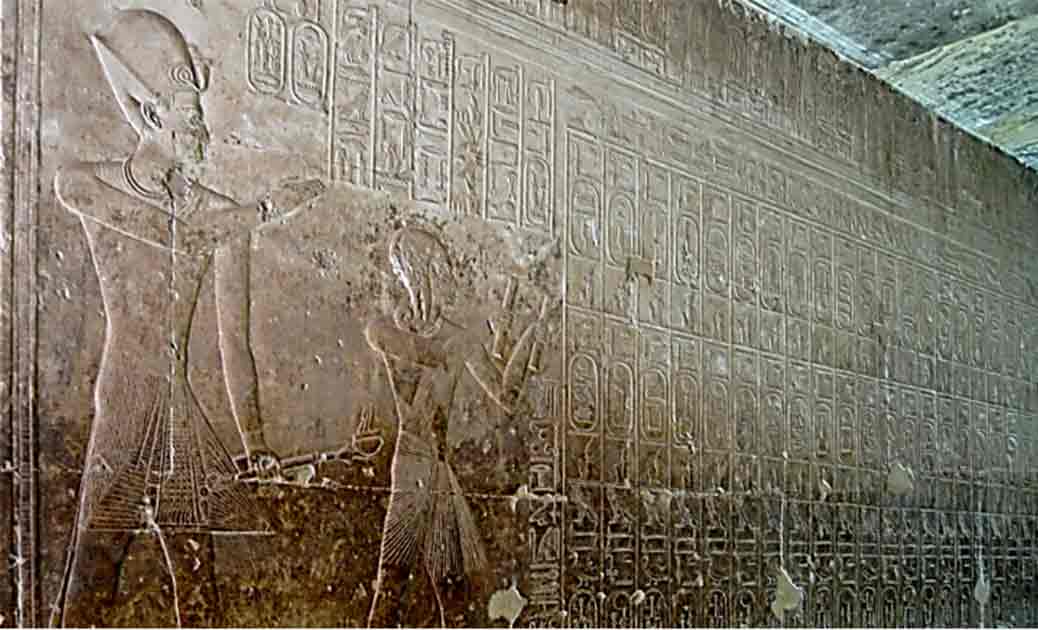The Abydos King List Safeguards the Identities of 76 Egyptian Kings
Abydos is one of the oldest ancient Egyptian cities (3,100 – 332 BC) and is one of the most important archaeological sites in all of Egypt. Many ancient temples and tombs can be found there, offering a glimpse into ancient Egyptian history, the people who lived during those times, and the historical events that occurred. Abydos developed into a very important cult site in ancient Egypt, as eventually it became very desirable to be buried there. One of the most important sites in Abydos is the Temple of Seti I. Within this temple is a list of seventy-six Egyptian kings. This list has served as an important tool in piecing together ancient Egyptian history, and in identifying the rulers from that time.
- The stunning temple of Seti I in Abydos, Egypt
- New Pharaoh Discovered in Egypt – Introducing King Seneb Kay
Exploring the Rival Kingdoms of Memphis, Thebes, and Herakleopolis
The list (sometimes referred to as the King Table) contains three rows of 38 cartouches. A cartouche is a type of oval border which indicates that the name within is the name of a king. This list gives the names of ancient Egyptian kings in chronological order and is the sole naming source of many of the kings from the Seventh and Eighth Dynasties.
The names contained on the Abydos King list are numerous – 76 in all - including more commonly known ones such as: Khufu, Sneferu, Amenhotep, and Seti.
If you have done the math and are wondering why 3 rows of 38 only provides 76 kings, it is because the third line is dedicated solely to a repetition of the cartouche and nomen of Seti.
While the list is highly valuable due to the names it provides, it is not comprehensive, and highly favors the Memphite kings. Of the three rival kingdoms, Memphis, Thebes, and Herakleopolis, Memphite kings are predominant, none of the Herakleopolitan kings are included, and Theban kings were only included at a point after Memphis ceased to exist.
- Egyptian Temples and the Order of Creation: Embodying Eternity in Time
- Archeologists discover Mythical Tomb of Osiris, God of the Dead, in Egypt

Detail of the Abydos King list in Egypt. (Public Domain)
Several Egyptian kings were omitted from the list, including Akhenaten (Amenhotep IV), Tutankhamun, Ay, Hatshepsut, and Meryneith. It is supposed these kings were considered illegitimate, and certainly in Hatshepsut’s case, there was an ancient attempt to scrub the records bare of her name and existence.

Drawing of more of the cartouches in the Abydos King List. (PLstrom/CC BY-SA 3.0)
Seti I's Legacy: Crafting Ancestral Bonds in Stone
Like many other lists detailing the history of a region as set by their leaders, the Abydos table is not a complete historical documentation, however, it does reflect the cultural situation at the time. Some scholars suggest the list, as set down by Seti I, was to represent the royal ancestors in a ritual, performed on their behalf. Seti I himself was not of royal lineage, and so to ensure his own legitimacy he may have constructed a grand temple worthy of the gods and filled it with the names of legitimate ancestors.

The façade of the temple of Seti I in Abydos, Egypt. (Steve F-E-Cameron/CC BY 3.0)
Despite his more common background, Seti was an important figure in Egyptian history. He strove to re-establish Egyptian sovereignty over Syria and the Levant in the aftermath of the disorder caused by Akhenaten’s religious reforms.
The temple itself is cited by many as the most impressive religious structure still standing in Egypt. It did much to reassure the people of Egypt that the old gods were not forbidden, and it symbolized a return to tradition.

Tall and imposing, highly decorated pillars line the Temple of Seti I, in Abydos, Egypt. (Public Domain)
It was believed to be the place where Osiris was buried, and as such is an important cult center. The sprawling limestone temple contained two open courts, two hypostyle halls, seven shrines, a chapel, and many other chambers. There was also a submerged tomb-like Osireion at the back.
The king list within the Temple of Seti in Abydos provides important information and insight into ancient Egyptian culture and history. Even with the omissions, the Abydos King list is invaluable in identifying tombs and naming Egyptian Kings whose names might otherwise have been lost in the sands of time.
Top image: The Abydos Kings list cartouches in the Temple of Seti, Abydos. Source: Olaf Tausch/CC BY 3.0
By M R Reese
References
Abydos Kings List – Ancient Egypt. Available at: http://www.ancientegyptonline.co.uk/abydoskl.html
List of Kings, Temple of Seti I, Abydos. Available at:http://www.360cities.net/image/list-of-kings-temple-of-seti-1-abydos-egypt#-40.48,-25.78,90.0
Abydos King List – Phouka. Available at: http://www.phouka.com/tr/egypt/history/KLAbydos.html
The Royal Tradition in Upper Egypt from Menes to Sety I – Abrock. Available at: http://www.abrock.com/MudloffSite/Ancient_Egypt.html




















Comments
Hey Jake the whitey, stop thinking your God's chosen, stop thinking your above the law, stop being ignoirant
Black people get a job and quit breaking the law.
I like how the "cult" word came out AWFUL quick! Thank you!
Archaeologists are from all nationalities and races.
White people leave these dead kings alone.
Pages